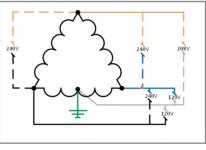kwired
Electron manager
- Location
- NE Nebraska
- Occupation
- EC
Even though you have been told it is not a great idea to use the high leg to supply this load, if you would do so proper method would to be run a "hot" (the high leg), a white (neutral) and an equipment grounding conductor to the load. Is in just about every way no different than supplying any 120 volt load from an ungrounded conductor to a grounded conductor. You have 2 conductors at ground potential but one is carrying load current the other is a non current carrying bonding conductor and only is supposed to carry current in abnormal conditions.Guys,
Ungrounded equipment incase there's a short is where I was confused... not sure what would happen and wouldn't want to touch the unit.
The load is small (12A 208V on a 100A 3PH disconnect and it's only for testing not permanent) but still dont know what would happen if there is a heating element failure short to ground.
Thanks again
Not a great idea to do so because of source operation issues and not really a code violation to connect a 208 volt load to this high leg. Some the code limitations have been mentioned though. You basically won't find a single pole breaker rated for the voltage unless you get into 277/480 series breakers/panels, you can get 240 straight rated breakers in 2 pole units, but they are not popular sellers and because of that tend to be expensive and probably not stocked in many places either. 3 pole breaker will be 240 volt straight rated but also has higher cost compared to a single poled and it burns two additional spaces in the panel.
If you keep this high leg to neutral load fairly minimal you probably get away with it with little or no issues, but if you had a lot of such load, it can be harder to predict how the loading though the transformer(s) comes out, other 120 volt loading will impact how things ultimately balance out


